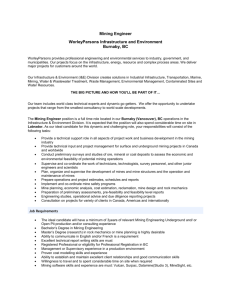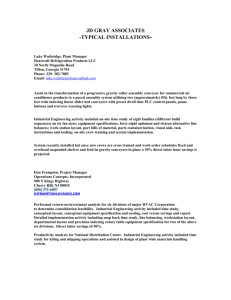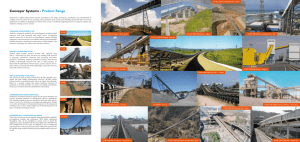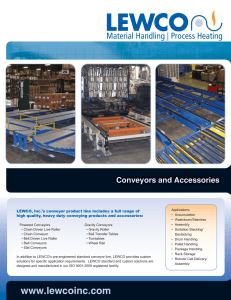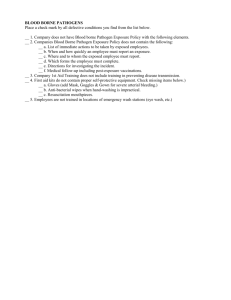Department of Mining Engineering, University of Missouri
advertisement
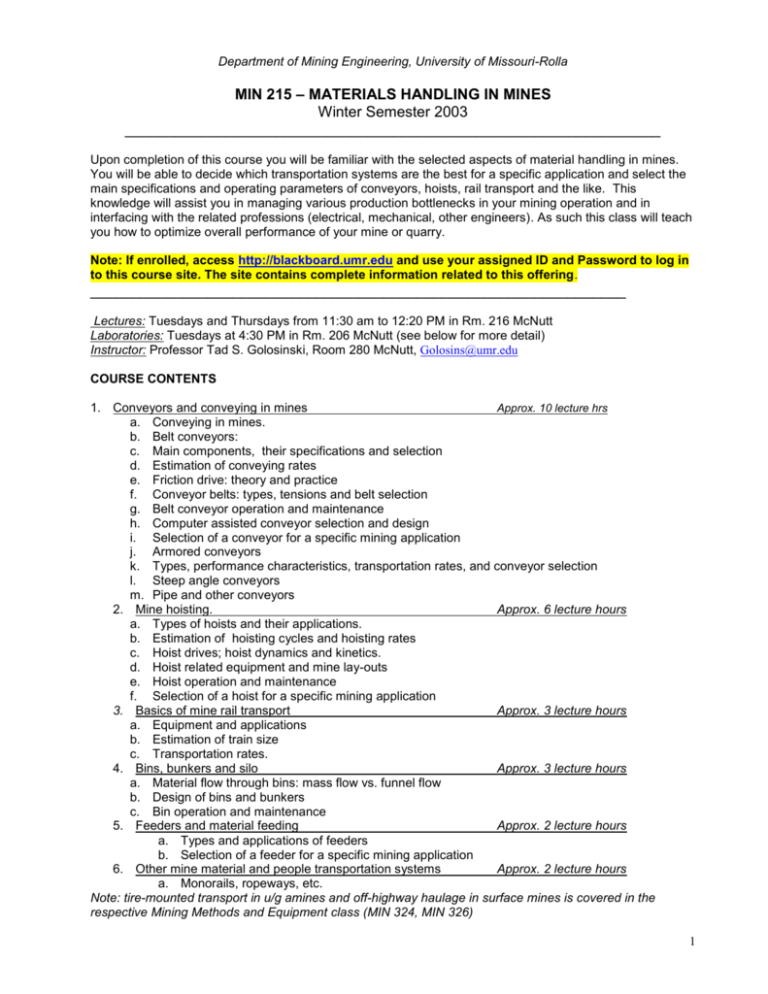
Department of Mining Engineering, University of Missouri-Rolla MIN 215 – MATERIALS HANDLING IN MINES Winter Semester 2003 ________________________________________________________________ Upon completion of this course you will be familiar with the selected aspects of material handling in mines. You will be able to decide which transportation systems are the best for a specific application and select the main specifications and operating parameters of conveyors, hoists, rail transport and the like. This knowledge will assist you in managing various production bottlenecks in your mining operation and in interfacing with the related professions (electrical, mechanical, other engineers). As such this class will teach you how to optimize overall performance of your mine or quarry. Note: If enrolled, access http://blackboard.umr.edu and use your assigned ID and Password to log in to this course site. The site contains complete information related to this offering. ________________________________________________________________ Lectures: Tuesdays and Thursdays from 11:30 am to 12:20 PM in Rm. 216 McNutt Laboratories: Tuesdays at 4:30 PM in Rm. 206 McNutt (see below for more detail) Instructor: Professor Tad S. Golosinski, Room 280 McNutt, Golosins@umr.edu COURSE CONTENTS 1. Conveyors and conveying in mines Approx. 10 lecture hrs a. Conveying in mines. b. Belt conveyors: c. Main components, their specifications and selection d. Estimation of conveying rates e. Friction drive: theory and practice f. Conveyor belts: types, tensions and belt selection g. Belt conveyor operation and maintenance h. Computer assisted conveyor selection and design i. Selection of a conveyor for a specific mining application j. Armored conveyors k. Types, performance characteristics, transportation rates, and conveyor selection l. Steep angle conveyors m. Pipe and other conveyors 2. Mine hoisting. Approx. 6 lecture hours a. Types of hoists and their applications. b. Estimation of hoisting cycles and hoisting rates c. Hoist drives; hoist dynamics and kinetics. d. Hoist related equipment and mine lay-outs e. Hoist operation and maintenance f. Selection of a hoist for a specific mining application 3. Basics of mine rail transport Approx. 3 lecture hours a. Equipment and applications b. Estimation of train size c. Transportation rates. 4. Bins, bunkers and silo Approx. 3 lecture hours a. Material flow through bins: mass flow vs. funnel flow b. Design of bins and bunkers c. Bin operation and maintenance 5. Feeders and material feeding Approx. 2 lecture hours a. Types and applications of feeders b. Selection of a feeder for a specific mining application 6. Other mine material and people transportation systems Approx. 2 lecture hours a. Monorails, ropeways, etc. Note: tire-mounted transport in u/g amines and off-highway haulage in surface mines is covered in the respective Mining Methods and Equipment class (MIN 324, MIN 326) 1 MARKING Laboratories (six @ 5% each) 30% of your mark Home assignments 30% of your mark Expect six assignments, one each two weeks, each counting for 5% Mid-term examination 20% of your mark Final examination 20% of your mark Note: Individual marks will be assigned based on the following distribution: about 40% of A’s, about 40% of B’s, the rest consisting of C’s, D’s, F’s, etc. REFERENCES (there is no textbook for this course but you need an access to the following references) 1. Bise, C. J. 1986. Mining Engineering Analysis. Society of Mining Engineers Inc. 2. Conveyor Equipment Manufacturers Association. 1997. Belt Conveyors for Bulk Materials, 5th ed. 3. Hartman H. L (ed.). 1992. SME Mining Engineering Handbook. Society of Mining Engineers.: 3. Hustrulid W.A.(ed). 1982. Underground Mining Methods Handbook. Society of Mining Engineers: Ch. 5.2.8. Rail Haulage Systems Ch. 5.2.9. Underground Belt Conveyors Ch. 5.4. Ancillary Equipment LABORATORIES Lab format: Six laboratories are scheduled for this course. Each lab will include a one hour lecture followed by physical experiments conducted by groups of five to six students. Note that most groups will have to conduct the experiments at a time different from that given in the timetable. Think whom do you want to join with in a group. Individual lab report is required for each lab (see below). The labs will begin early in September and run till the end of November. Details of timing, student assignment to a specific group and other related matters will be announced during the lectures. Lab Report: The report is to be typed with a minimum of five pages and a maximum of eight pages including title page, plots, drawings and appendix. Following format is to be used: A. Cover page: Institution, student name & ID, Lab title and an executive summary B. Body of the report: 1. Objective 2. Theory and background information 3. Laboratory procedures used 4. Recorded data, its analysis and results; use graphs if applicable 5. Discussion and recommendations 6. References C. Appendix (if applicable) Check the course Blackboard site for a sample Report due date: All reports are due one week after the lab took place. Penalty of 30% will apply if the report is submitted up to one week late, 50% during the second week and 100% for reports more than two weeks late. Yes, you must submit the report even with the penalty is 100%, if you want to earn a credit for this course. Lab marking: Each lab report will be worth 5% (for the total of 30 % considering that there are six labs in this course). In addition to lab content and organization, lab report will also be marked on format and writing (up to one-fifth of the mark). Attendance: Attendance is mandatory, except for unusual circumstances brought to the attention of the instructor in advance and approved. COMMENTS Attend the lectures, as some of the material may not be well covered in the references. Take notes. Listen to the announcements and stick by the deadlines. Secure access to the listed references and make sure that you review those when appropriate. If you experience problems with this course contact the instructor without delay. Talk to your friendly lecturer if in trouble, if you experience difficulties or if you have any other problems. The sooner you talk the better the chance that the problem will be solved. YOU ARE HERE TO LEARN, WE ARE HERE TO FACILITATE YOUR LEARNING Good luck 2



